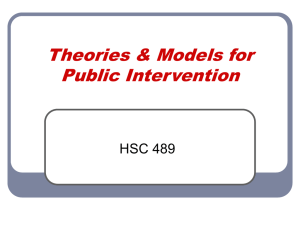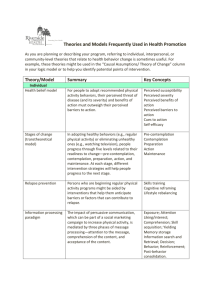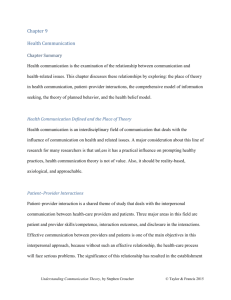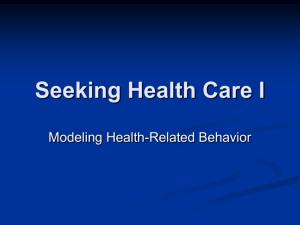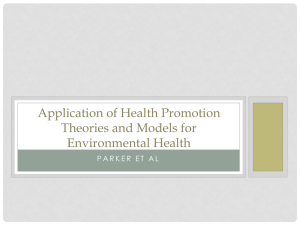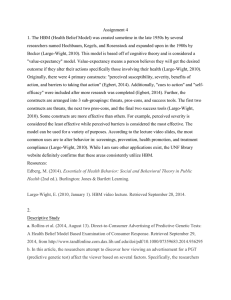Sp12 HE385 Theory
advertisement
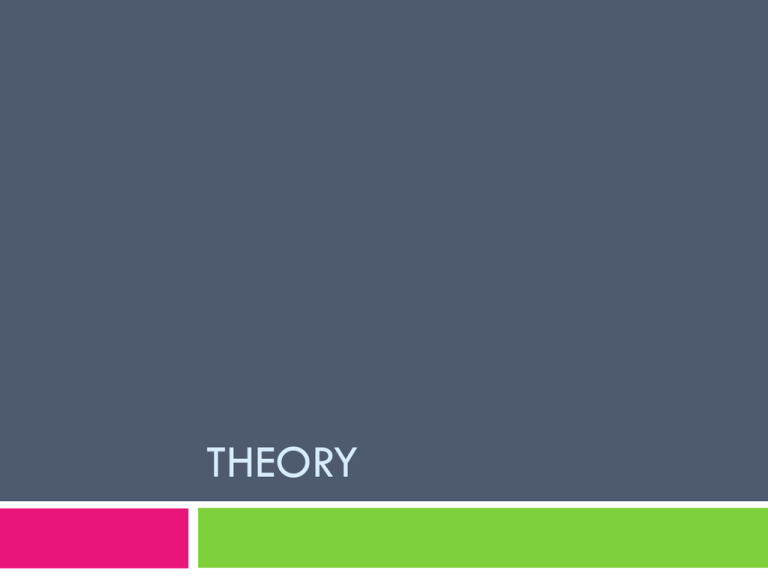
THEORY What is theory? “… a set of interrelated concepts, definitions, and propositions that presents a systematic view of events or situations by specifying relationships among variables in order to explain and predict the events or the situations.” (Glanz, Rimer, and Lewis, p. 25) Theory “Effective health promotion and education depends on practitioners’ marshaling the most appropriate theory and practice strategies for a given situation.” “The gift of theory is that it provides conceptual underpinnings for well-crafted research and practice.” (Glanz, Rimer, & Lewis, pp. 30-31) Theory Generality Testability Shape and boundaries, but not specific topic or content Variables Theories are used to … Guide the search for why people behave in certain ways Help pinpoint information needed before developing and organizing an intervention program Provide insight as to how to shape strategies to reach people Help identify what should be monitored, measured, and compared Concepts & Constructs Concepts: Major ideas Constructs: Concepts that have been developed and defined for use in a particular theory More theory “Habit is habit, and not to be flung out of the window, but coaxed downstairs a step at a time.” Mark Twain Theories and Levels of Influence Behavior is very complex Influenced and supported in multiple ways The Ecological Model Emphasizes the links and relationships among multiple factors (or determinants) affecting health Ecological Model Public Policy Community Institutional or Organizational Interpersonal Individual Individual / Intrapersonal factors Knowledge, attitudes, beliefs (KAB) Skills Motivation Self-concept Age, gender, genetics Interpersonal factors Social support / social networks Social norms, cultural environment Religious affiliation Access to social and health services Institutional or organization factors Educational system Access to health care Social Interactions Community factors Living and working conditions Public safety Local public health Housing Economic development Environment Public Policy Factors Federal, State & Local Policy and Law Zoning Taxes Public Health System Educational System Behavior Change Theories The specific route(s) you will take to reach your destination – they suggest a road to follow. Behavior change theories with individual focus The Health Belief Model (HBM) ** The Transtheoretical Model (TTM) ** Theory of Planned Behavior (TPB) ** Other Theories: Elaboration Likelihood Model of Persausion Information – Motivation – Behavioral Skills Model Health Action Process Approach Health Belief Model (HBM) Developed in the early 1950’s by social psychologists in the U.S. Public Health Service. Hochbaum & Rosenstock TB screening Constructs of HBM Perceived threat Perceived Beliefs about one’s chances of getting a condition Perceived Beliefs susceptibility severity about how serious the condition might be Constructs of HBM Outcome Expectations Perceived Benefits Beliefs that the advised action will reduce risk or seriousness of the condition. Perceived Beliefs risks/barriers about the “costs” of taking the advised action Constructs of HBM Cues to Action Strategies to activate one’s “readiness” Self-Efficacy Confidence in one’s ability to take action Health Belief Model Modifying Factors: age, race, ethnicity, SES, personality Perceived Susceptibility & Perceived Seriousness Perceived Threat Cues to Action Outcome Expectations: Perceived Benefits vs. Perceived Risks/Barriers Likelihood of taking recommended action Self-efficacy Theory of Reasoned Action (TRA) Constructs: Attitude toward the behavior Beliefs about the behavior Evaluation of behavioral outcomes Subjective What norms others think about your behavior How motivated you are to comply with the expectations of others TRA Cont. Beliefs and Subjective Norms help predict Intentions Your Intentions predict your actual Behavior TRA Attitude toward behavior Intention Subjective Norm Behavior Theory of Planned Behavior (TPB) Developed by Fishbein & Ajzen An extension of the Theory of Reasoned Action (TRA) TPB versus TRA Adds the construct: Perceived Behavioral Control Belief about personal control in combination with belief about the one’s ability to do what needs to be done. Actual Behavioral Control: have the skills and resources needed to quit. TPB Cont. People will perform a behavior if: They believe the advantages of success outweigh the disadvantages of failure. They believe that other people with whom they are motivated to comply, think they should perform the behavior. They have sufficient control over the factors that influence success or ability to perform the behavior. TPB Attitude toward the behavior Intention Behavior Subjective Norm Perceived Behavioral Control Actual Behavioral Control Transtheoretical Model (TTM) AKA: Stages of Change Developed by Prochaska & DiClemente Major Constructs: Precontemplation Contemplation Preparation Action Maintenance Decisional Balance Self-Efficacy Precontemplation “The shoes are still at the store” Not thinking about changing behavior in the next six months. May be unaware of risks or problems. Needs some work “under the hood.” Contemplation “Shoe shopping” Seriously thinking about making a behavior change, but have not yet made a commitment to action Preparation “You bought the shoes” Ready to take action in the very near future (next 30 days) Have a plan of action Experimenting with new behaviors Action “Wearing your shoes on a regular basis” Actively engaged in new behavior(s) for less than six months. Efforts are sufficient to reduce risk of disease Maintenance “Shoes go on every day.” Sustaining the behavior change for over 6 months. Decisional Balance The costs and benefits of changing. Self-Efficacy Confidence that one can be successful in the new behavior across different challenging situations. Relapse More likely when you are stressed, anxious, or feeling depressed. More likely if you lack social support or are experiencing interpersonal conflicts More likely if you return to a setting (environment) that “cues” your old behavior(s) Precontemplation Transtheoretical Model (TTM) Decisional Balance Contemplation Preparation Between every stage, the client needs to have decisional balance and self-efficacy Decisional Balance Action Maintenance Pro’s of TTM Encourages less “labeling” terms. (Precontemplation rather than “loser” or “lost cause”) Must accept people “where they are” Behavior change is not viewed as linear It is easy to stage clients It is not based on an instant gratification mentality Allows for stage-matched interventions How to stage a person using TTM Do you exercise regularly? No Yes Do you intend to in the next 30 days? Yes No Do you intend to in the next six months? No Preparation Have you been doing so for more than 6 months? No Yes Action Maintenance Yes Precontemplation Contemplation (Pearson Ed, 2012) Adapted from: Autobiography in Five Short Chapters by Portia Nelson I I walk down the street. There is a deep hole in the sidewalk. I fall in I am lost … I am helpless It takes forever to find a way out. II I walk down the same street. There is a deep hole in the sidewalk. I pretend I don’t see it. I fall in again. I can’t believe I am in the same place. It still takes a long time to get out. III I walk down the same street. There is a deep hole in the sidewalk. I see it is there. I still fall in … it’s a habit. My eyes are open. I know where I am. I get out immediately. IV I walk down the same street. There is a deep hole in the sidewalk. I walk around it. V I walk down another street. Behavior change theories with interpersonal focus Social Cognitive Theory (SCT) ** Social Network Theory (SNT) Social Capital Theory Social Cognitive Theory (SCT) A behavior change theory with an Interpersonal / Social network focus. Reciprocal Determinism Characteristics of the Person Environment in which the behavior is performed Behavior of the person Constructs of SCT Behavior Capacity Self-Efficacy Expectations Reinforcement Expectancies Self-Control / SelfRegulation Observational Learning Emotional Coping Responses Principles of Modeling Attention Remembering Model Similarity Age Gender Repetition Motivation Status Competence Reinforcement Any action or event that increases the desired behavior Present something positive Money New clothes Remove something negative Nagging Teasing Punishment Any action or event that decreases the likelihood that the desired behavior will occur. Present something negative Criticize Policies Remove or laws something positive Praise Privilege Political Population Level Community Organizational/Institutional Framework: Social Networks Interpersonalof Health Social Determinants Individual Ecological Model Behavior theories with community focus Diffusion of Innovation Theory (DF) ** AKA: Diffusion Theory Community Readiness Model (CRM) Diffusion of Innovations Theory Rogers, 1983 A behavior change theory with a community focus Diffusion of Innovations The progressive adoption by members of a community or society of an idea or practice over time. Adoption Curve Categories of Adopters Innovators (<3%) Independent, risk-takers, eager to try new ideas Not necessarily the most respected members of the community Seek info on their own, rely on their own judgment in making decisions about adoption Try out new ideas and provide the first tests of the utility of the innovation Categories of Adopters Early Adopters (14%) Respected members of the community Opinion leaders Powerful influence on other potential adopters Trendy … like to be up on what is good and new Seen as opinion leaders Categories of Adopters Early Majority (34%) Greatly influenced by mass media and opinion leaders By virtue of their numbers, they begin to form a new norm Lots of contact with peers, but don’t hold leadership positions. Categories of Adopters Late Majority (34%) Skeptical of change Tend to wait until an innovation is established as a norm before adopting Motivation Don’t is greatly influenced by peers like risk and uncertainty Categories of Adopters Laggards (16%) Very traditional and conservative Tend to have less education and lower SES Socially and geographically mobile Narrow and restricted communication networks Suspicious of innovations and adverse to risk Determinants of Diffusion’s Speed and Extent Is the innovation better than what it will replace? Does the innovation fit with the intended audience? Is the innovation easy to use? Can the innovation be tried out before adopting? Are the results of the innovation observable and easily measured? A few more pieces Predisposing, Reinforcing, and Enabling Factors Barriers to change PRECEDE/PROCEED behavioral diagnosis phase Predisposing Factors Provide the rationale or motivation for a person or group to act KAB (knowledge, attitudes, beliefs) Personal preferences Existing skills Self-efficacy beliefs Individual level theories Intrapersonal these factors. are most appropriate for addressing Reinforcing Factors Factors that provide reinforcement and reward for actions and encourage repetition of the action Social support Peer influence Significant others (family, spouse, partner) Employers, teachers, health providers, community leaders, decision-makers Reinforcing Factors Continued Interpersonal level theories are most appropriate in addressing these factors Interpersonal level theories suggest communication channels (e.g. significant others or social networks) and methods (e.g. incentives or social supports). Enabling Factors Factors that provide the means or make the action possible. Availability Accessibility of programs or services or skills training of programs or services or skills training
